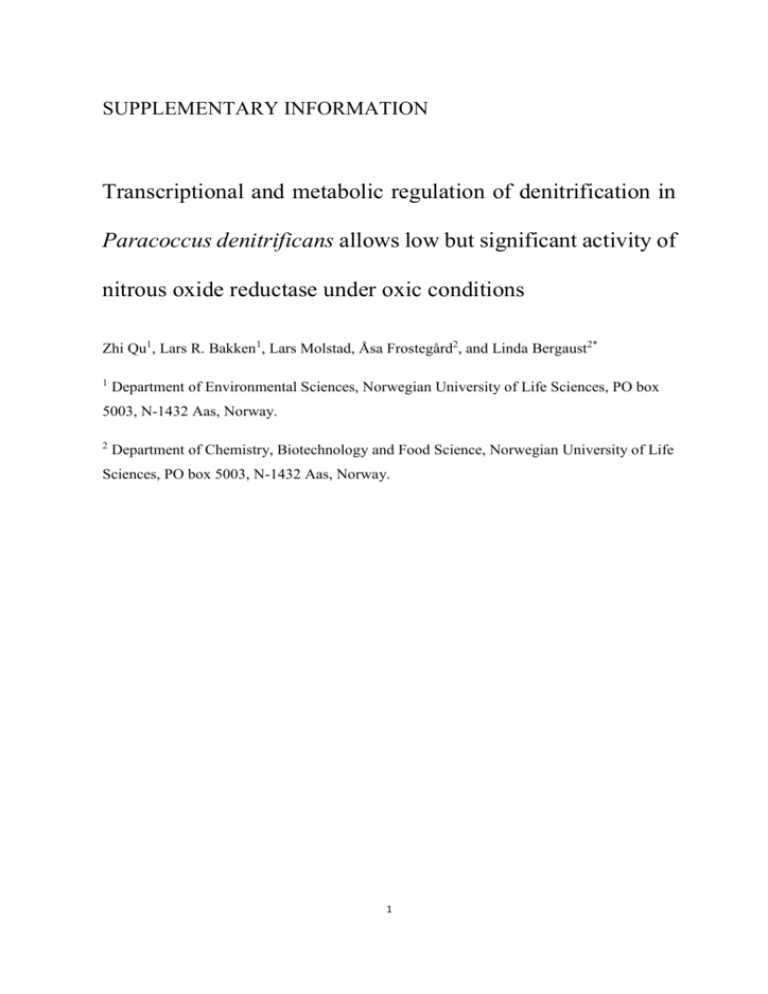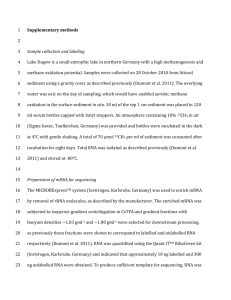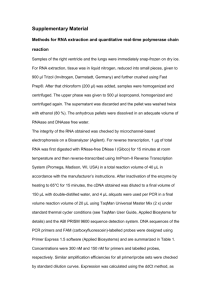emi13128-sup-0001
advertisement

SUPPLEMENTARY INFORMATION Transcriptional and metabolic regulation of denitrification in Paracoccus denitrificans allows low but significant activity of nitrous oxide reductase under oxic conditions Zhi Qu1, Lars R. Bakken1, Lars Molstad, Åsa Frostegård2, and Linda Bergaust2* 1 Department of Environmental Sciences, Norwegian University of Life Sciences, PO box 5003, N-1432 Aas, Norway. 2 Department of Chemistry, Biotechnology and Food Science, Norwegian University of Life Sciences, PO box 5003, N-1432 Aas, Norway. 1 Gene expression analyses While the main paper only includes the results from cultures supplied with succinic acid as carbon source, we did run additional gas kinetics and gene expression analyses in cultures growing on butyric acid. The transcription profiles were similar and are reported below, alongside the corresponding gas kinetics (Fig S3). Also included are the individual data points for the biological replicates, both in succinic- and butyric acid treated cultures (Figs S1 and S4, respectively), primer/probe sequences for the four genes tested (Table S1), and estimated total RNA yield cell-1 in each sample from cultures grown with succinic acid as substrate (Fig S2). Table S1: List of primers used for gene expression analysis, and the efficiencies, intercepts and corresponding R2 values of the standard curves (average (stdev); n=3). narG nirS norB nosZ standard curves Primer/probe sequence (5’3’) Gene Forward: GGATGCGCGCCTTTGG Reverse: CGCACCCACGGTCTTGA Probe: FAM-CAGGTCACGAAGCCCT Forward: CTACCTGCAAAGCTTCATCACCTA Reverse: AGCAGGTAGTTCGCCATCAG Probe: FAM-TCGGCGGTCAGCTCG Forward: GGCTGCTGGGCAAGGA Reverse: GCGATGCCGAGCTTGAC Probe: FAM-CTGGAACAGCCGAAATG Forward: CAATGGCAAGCGCATCCA Reverse: GCCCTCGGTAAAGGACATGTG Probe: FAM-CAGGTCGCCGTTGTC 2 Efficiency Intercept R2 0.944(0.004) 39.38(0.18) 0.9996 (0.0003) 0.921(0,004) 40.24(0.95) 0.9997 (<0.0001) 0.972(0.004) 39.01(0.28) 0.9997 (0.0002) 0.987(0.005) 38.81(0.44) 0.9997 (0.0002) copies ng-1 RNA 1.0E+5 1.2E+5 narG 8.0E+4 nirS 1.0E+5 8.0E+4 6.0E+4 6.0E+4 4.0E+4 4.0E+4 2.0E+4 2.0E+4 0.0E+0 0.0E+0 0 20 40 0 60 20 copies ng-1 RNA 2.0E+5 norB 1.2E+5 60 40 60 Time (h) Time (h) 1.4E+5 40 nosZ 1.6E+5 1.0E+5 8.0E+4 1.2E+5 6.0E+4 8.0E+4 4.0E+4 4.0E+4 2.0E+4 0.0E+0 0.0E+0 0 10 20 30 40 50 60 0 Time (h) 20 Time (h) Figure S1: Comparison of gene transcription kinetics of the biological replicates; medium containing 5 mM succinic acid. The three replicates are separated with different colors. The kinetics of narG, nirS, norB and nosZ gene transcription are shown in the four panels as labelled. 16 ×10-7 ng RNA cell-1 14 12 10 8 6 4 2 0 0 10 20 30 40 50 60 Time (h) Figure S2: Estimated total RNA yield per cell in each sample; medium containing 5 mM succinic acid. 3 O2 (); Nitrite, N2-N (mol vial-1) 100 Butyric acid N2-N 25 N2O-N 80 NO-N NO2O2 60 40 20 15 1.0 10 .5 20 5 0.0 30 20 10 0 0 0 narG, nirS, norB, nosZ (copies ng-1 RNA) 30 20 10 0 (b) NO-N (nM), N2O-N (nmol vial-1) 30 (a) 40 50 60 70 6e+4 5e+4 narG nirS norB nosZ 1e+5 1e+4 4e+4 1e+3 1e+2 3e+4 1e+1 1e+0 30 20 10 0 2e+4 1e+4 0 0 10 20 30 40 50 60 70 Time (hour) Figure S3. Gas kinetics and gene transcription throughout the transition from aerobic to anaerobic respiration; medium containing 5 mM butyric acid. Panel (a) shows O2 and NO (concentration in liquid, µM and nM, respectively), N2O-N (nmol N vial-1), NO2- and N2-N (μmol N vial-1).The number of gene transcripts per ng RNA is shown in panel (b) with standard deviation as vertical lines (n=3). The sample at time 0 is the result for the inoculum (prior to inoculation). The transcriptions of all genes during the semi-aerobic phase are shown in the inserted panel on log-scale. 4 4.0E+4 2.5E+4 copies ng-1 RNA narG nirS 2.0E+4 3.0E+4 1.5E+4 2.0E+4 1.0E+4 1.0E+4 5.0E+3 0.0E+0 0.0E+0 0 20 40 60 80 0 20 Time (h) 6.0E+4 2.5E+4 norB 60 80 60 80 nosZ 5.0E+4 2.0E+4 copies ng-1 RNA 40 Time (h) 4.0E+4 1.5E+4 3.0E+4 1.0E+4 2.0E+4 5.0E+3 1.0E+4 0.0E+0 0.0E+0 0 20 40 60 0 80 20 40 Time (h) Time (h) Figure S4: Comparison of gene transcription kinetics of the biological replicates; medium containing 5 mM butyric acid. The three replicates are separated with different colors. The kinetics of narG, nirS, norB and nosZ gene transcription are shown in four separate panels as labelled. N2OR recovery after O2 exposure; pre-screening We wanted to establish whether apparent recovery of N2OR activity in anaerobically raised cells as O2 approached depletion (Fig 3, main paper) was due to de novo synthesis alone, or could also reflect recovery of “old enzyme”. One way of testing this is to stall translation in an actively denitrifying culture without inhibiting the activity of the existing proteome. It was thus necessary to test the effect of a range of chloramphenicol concentrations on respiration rate and relative concentrations of gaseous intermediates during denitrification. This pre-screening is outlined in Fig S5. 5 Figure S5: Identifying suitable chloramphenicol (Cm) concentration for N2OR recovery experiment. Denitrifying cultures of P. denitrificans were raised through three anoxic batch generations, each with 1 mM initial nitrite. After electron acceptor depletion, 1.2E8 cells were transferred to sterile anoxic medium with 1 mM initial nitrite. Headspace gases were monitored for approximately 17 hours before addition of Cm (0, 5, 10 or 20 µg/mL, n=3). Subsequent respiration was then monitored for 45 hours. All Cm concentrations lead to immediate decline in anoxic respiration rates (µmol e- vial-1 h-1), however, less pronounced in cultures treated with 5 µg/mL as compared to the others. In cultures with 10 and 20 µg/mL Cm, respiration rates continued to drop throughout the incubation, while staying constant in the 5 µg/mL treatment at 4.17 ± 0.08 µmol vial-1 h-1 before an apparent recovery after approximately 20 hours. The N2OR recovery test, was run within a timeframe of 10 hours from Cm addition (* in figure), and 5 µg/mL Cm was thus chosen as the concentration most suitable for the main experiment. 6 Calculation of protein density from observed transcript density In a growing culture of cells, proteins are produced and degraded in each cell. At the same time, the proteins are diluted due to the cell growth and division. We wish to find an equilibrium value of the number of molecules of a given enzyme per cell. In other words, we want to find the ratio 𝑁𝐸 /𝑁, where 𝑁𝐸 is the number of molecules of the enzyme, and 𝑁 is the number of cells in an exponentially growing culture. If we assume first order degradation of the enzyme pool, we can calculate the net rate of change of 𝑁𝐸 as 𝑑𝑁𝐸 = 𝑣𝑡𝑟𝑙 𝑁𝑛𝑚𝑅𝑁𝐴 − 𝛿𝐸 𝑁𝐸 𝑑𝑡 (1) where 𝑣𝑡𝑟𝑙 is the translation rate (protein molecules per mRNA molecule per second), 𝑛𝑚𝑅𝑁𝐴 is the average number of mRNA molecules per cell, and 𝛿𝐸 is the first order degradation rate of the enzyme. At the same time, the cell culture is growing 𝑑𝑁 = 𝜇𝑁 𝑑𝑡 (2) The number of enzyme molecules per cell will approach an equilibrium value at which the relative growth rates of 𝑁𝐸 and 𝑁 must be equal: 1 𝑑𝑁𝐸 1 𝑑𝑁 = 𝑁𝐸 𝑑𝑡 𝑁 𝑑𝑡 (3) (Otherwise the 𝑁𝐸 : 𝑁 ratio would change with time.) Hence, 𝑣𝑡𝑟𝑙 𝑁𝑛𝑚𝑅𝑁𝐴 − 𝛿𝐸 𝑁𝐸 =𝜇 𝑁𝐸 (4) Rearranging this, we arrive at 𝑁𝐸 𝑣𝑡𝑟𝑙 𝑛𝑚𝑅𝑁𝐴 = 𝑁 𝛿𝐸 + 𝜇 (5) More formally, we can use the l’Hopital rule: 7 𝑁𝐸 𝑑𝑁𝐸 /𝑑𝑡 𝑣𝑡𝑟𝑙 𝑁𝑛𝑛𝑅𝑁𝐴 − 𝛿𝐸 𝑁𝐸 = lim = lim 𝑡→∞ 𝑁 𝑡→∞ 𝑑𝑁/𝑑𝑡 𝑡→∞ 𝜇𝑁 lim (6) Rearranging this gives the same result: 𝑁𝐸 𝑣𝑡𝑟𝑙 𝑛𝑚𝑅𝑁𝐴 = 𝑡→∞ 𝑁 𝛿𝐸 + 𝜇 lim (7) To calculate 𝑣𝑡𝑟𝑙 we use approximate values for two parameters: 1) the average lifetime of mRNA and 2) the number of translations per mRNA molecule during its lifetime. Härtig and Zumft (1999) determined the half-life of nirS transcripts in Ps. stutzeri to be 13 minutes, which is relatively long compared to most transcripts in E. coli (3-8 min; Bernstein et al., 2002). Assuming first order decay, the half-life of 13 minutes implies a decay rate (𝛿𝑚𝑅𝑁𝐴 ) of ln(2)/(13 min) = 3.2 h-1 . The lifetime of the mRNA molecules then follows an exponential probability distribution with expected value 1/𝛿𝑚𝑅𝑁𝐴 , or 19 minutes. This is our estimate of the average lifetime of the mRNA molecules. Let us further assume that each mRNA transcript produces on average 50 protein molecules (this is a reasonable number for mRNA with a long half-life; Bremer & Dennis 1996). We call this number 𝑄. The average rate of translation from one mRNA molecule equals the average number of protein molecules it produces divided by its average lifetime, which is then 𝑣𝑡𝑟𝑙 = 𝑄𝛿𝑚𝑅𝑁𝐴 (8) (We have assumed that the lifetime is independent of translation rate) And so 𝑁𝐸 𝑄𝛿𝑚𝑅𝑁𝐴 𝑛𝑚𝑅𝑁𝐴 = 𝑡→∞ 𝑁 𝛿𝐸 + 𝜇 lim (9) The decay rate of denitrification enzymes (𝛿𝐸 ) is not known, but a reasonable maximum value would be 0.06 (half-life = 12h) (Maier et al., 2011). Thus, for anoxic growth (µ=0.1 h-1), a steady state concentration of 1 mRNA molecule per cell (𝑛𝑚𝑅𝑁𝐴 =1) would result in a steady state enzyme concentration of 1000 molecules per cell. This estimate is relatively insensitive to the enzyme decay rate; it increases to 1500 if reducing the protein decay rate to 0.01 h -1. For oxic growth (µ=0.2 h-1), we get 615 protein molecules per cell. It should be noted, however, that the parameters used here are average values for proteins in E. coli, and these may be an order of magnitude off target for particular proteins because 8 bacteria appear to be able to regulate the rates of translation initiation for individual mRNA, as observed by ribosome profiling in E. coli (Li et al., 2014). Thus, the equilibrium number of enzyme molecules could be 10 times higher than predicted by equation 9, if the translation initiation is as high as that observed for particular proteins in E. coli (Li et al., 2014). Reference Maier, T., Schmidt, A., Güell, M, Kühner, S., Gavin, A.C., Aebersold, R., Serrano, L. (2011) Quantification of mRNA and protein and integration with protein turnover in a bacterium. Molecular Systems Biology 7:511. 9









